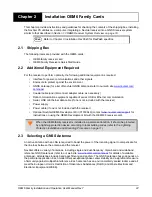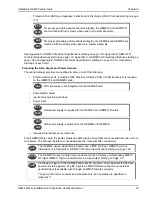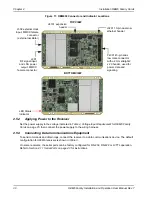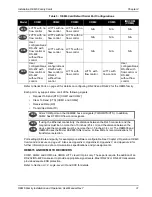
Installation OEM6 Family Cards
Chapter 2
OEM6 Family Installation and Operation User Manual Rev 7
27
•
Protection from ESD (see
Appendix G, Electrostatic Discharge (ESD) Practices
See
Appendix A, OEM615 Technical Specifications
page 112, Appendix C, OEM628 Technical Specifications
and
Appendix E, OEM638 Technical Specifications
for mechanical
drawings of each card.
Preparing the Data, Signal and Power Harness
The wiring harness provides connections to some or all of the following:
•
Communication ports, including COM, Ethernet, USB and CAN (a CAN transceiver is required
on the OEM615 and OEM628 cards)
•
Antenna/LNA power
•
Input and output timing strobes
•
Power input
•
Optional external frequency reference
For all OEM6 family cards, the power, status and data inputs and outputs are accessed from one or more
connectors. The harness therefore, must be designed to mate with this connector(s).
615
For proper grounding and mechanical integrity, the OEM615 and OEM617D
are mounted with four screws when used in a custom assembly.
628
For proper grounding and mechanical integrity, the OEM628 and OEM638 are
mounted with six screws when used in a custom assembly.
617D
638
638
CAN transceivers are integrated on the OEM638 card.
615
LNA power supply is required for the OEM615 and OEM617D cards.
628
LNA power supply is optional for the OEM628 and OEM638.
615
The OEM615 uses a single 20-pin header and a MCX RF input. OEM615 pin-out
information is in
Appendix A, OEM615 Technical Specifications
The OEM617D uses a single 20-pin header and has a Primary and Secondary MMCX
RF input. OEM617D pin-out information is in
628
As shown in
the OEM628 card uses 24-pin and a 16-pin headers for the data,
power and status signals: The RF input is an MMCX female connector. An external
oscillator input is available, also through an MMCX female connector.
The pin-outs for all connectors and manufacturers’ part numbers are specified in
617D
638
617D
















































